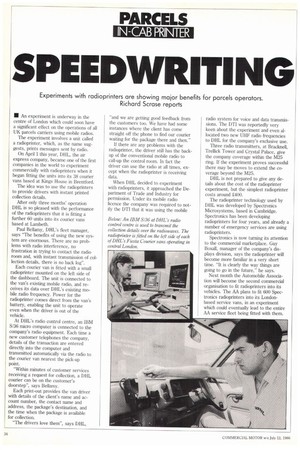SP DVI/RITING
Page 44

If you've noticed an error in this article please click here to report it so we can fix it.
Experiments with radioprinters are showing major benefits for parcels operators. Richard Scrase reports
• An experiment is underway in the centre of London which could soon have a significant effect on the operations of all UK parcels carriers using mobile radios.
The experiment involves a unit called a radioprinter, which, as the name suggests, prints messages sent by radio.
On April 1 this year, DHL, the air express company, became one of the first companies in the world to experiment commercially with radioprinters when it began fitting the units into its 38 courier vans based at Kings House in Brentford.
The idea was to use the radioprinters to provide drivers with instant printed collection details.
After only three months' operation DHL is so pleased with the performance of the radioprinters that it is fitting a further 60 units into its courier vans based at Lambeth.
Paul Bellamy, DHL's fleet manager, says "The benefits of using the new system are enormous. There are no problems with radio interference, no frustration in trying to contact the radio room and, with instant transmission of collection details, there is no back log".
Each courier van is fitted with a small radioprinter mounted on the left side of the dashboard. The unit is connected to the van's existing mobile radio, and receives its data over DHL's existing mobile radio frequency. Power for the radioprinter comes direct from the van's battery, enabling the unit to operate even when the driver is out of the vehicle.
At DHL's radio control centre, an IBM S/36 micro computer is connected to the company's radio equipment. Each time a new customer telephones the company, details of the transaction are entered directly into the computer and transmitted automatically via the radio to the courier van nearest the pick-up point.
"Within minutes of customer services receiving a request for collection, a DHL courier can be on the customer's doorstep", says Bellamy.
Each print-out provides the van driver with details of the client's name and account number, the contact name and address, the package's destination, and the time when the package is available for collection.
'The drivers love them", says DHL, "and we are getting good feedback from the customers too. We have had some instances where the client has come straight off the phone to find our courier waiting for the package there and then."
If there are any problems with the radioprinter, the driver still has the backup of the conventional mobile radio to call-up the control room. In fact the driver can use the radio at all times, except when the radioprinter is receiving data.
When DHL decided to experiment with radioprinters, it approached the Department of Trade and Industry for permission. Under its mobile radio licence the company was required to notify the DTI that it was using the mobile radio system for voice and data transmissions. The DTI was reportedly very keen about the experiment and even allocated two new UHF radio frequencies to DHL for the company's exclusive use.
Three radio transmitters, at Bracknell, Trellick Tower and Crystal Palace, give the company coverage within the M25 ring. If the experiment proves successful there may be moves to extend the coverage beyond the M25.
DHL is not prepared to give any details about the cost of the radioprinter experiment, but the simplest radioprinter costs around £400.
The radioprinter technology used by DHL was developed by Spectronics Microsystems, based in Cambridge. Spectronics has been developing radioprinters for four years, and already a number of emergency services are using radioprinters.
Spectronics is now turning its attention to the commercial marketplace. Guy Boxall, manager of the company's displays division, says the radioprinter will become more familiar in a very short time. "It is clearly the way things are going to go in the future," he says.
Next month the Automobile Association will become the second commercial organisation to fit radioprinters into its vehicles. The AA plans to fit 600 Spectrollies radioprinters into its Londonbased service vans, in an experiment which could eventually lead to the entire \ A service fleet being fitted with them.




















































































